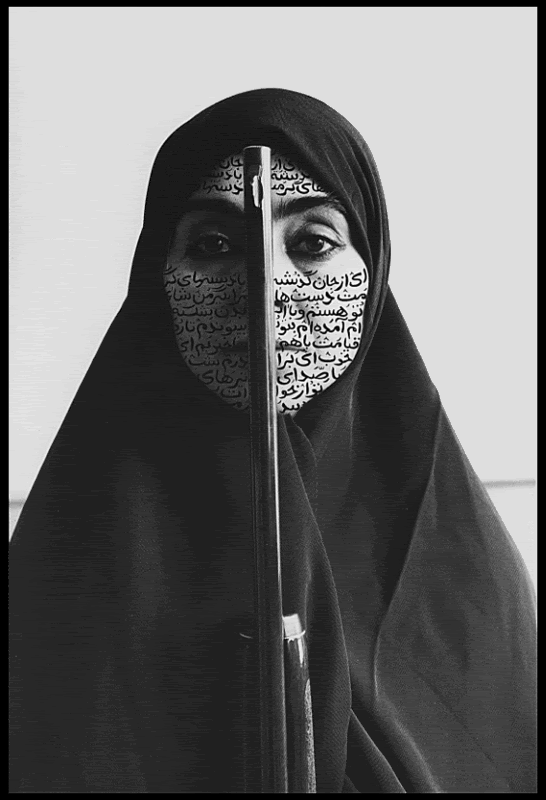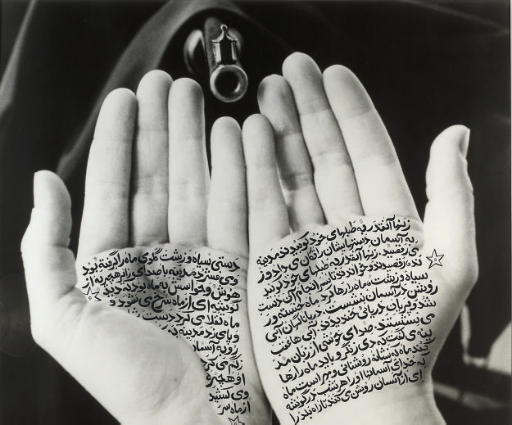Brandon Nacke
Shirin Neshat is an inspiring artist whose art deals with the repressing of Islamic women and her life as a diasporic artist living and working within a Western society. She uses feminist ideals from an Iranian perspective and incorporates it in accented forms with film and photography. As a conceptual artist, she challenges people preconceived notions and culturally imbedded stereotypes of women and their place in Islamic culture.
Born in the town of Qazvin in north-western Iran, she was the fourth of five children in a wealthy religious family. She was brought up in a westernized household and enrolled in a Catholic boarding school in Tehran. It was her father that believed in the integration of the west into their home and wanted his children to be educated in the United States. Being influenced by the western feminism, he encouraged his daughters to go against the norm and become individuals by learning and experiencing the world. It wasn’t until 1974 that she left home to study film at the University of California in Berkeley. However, four years later the Iranian Revolution occurred and Iran broke out into war with Iraq shortly thereafter. Due to this, Shirin lost contact with her family and wasn’t able to return until 1990. She regretted not being there with her friends and family during the traumatic times and envied their experience. Resulting in this coming together with her homeland and the realization of a commitment, she produced her first work of a series of photographs entitled Women of Allah (1996). Later collaborating with three fellow Iranians, Neshat gained large popularity in the art world with their three films, Turbulent, Rapture, and Fervour. (Creating an Artistic Self)
What is most appealing about Shirin Neshat is what she represents and how she conveys it through her art. There is an obvious sense of feminism in how she focuses on the oppression of Islamic women in society and the desire to be free. This sense of a desire and crisis can be recognized anywhere because, it is common and exists among all cultures. There is no existing culture today that doesn’t in one way or another deal with some type of prejudice, whether it be from sexism to racism, none is without it. By incorporating a universal truth that can be recognized, she is commenting on how there are similarities between all diverse cultures.
In terms of her role as a photography and video artist, she works very strongly within accented cinema. Hamid Naficy describes accented cinema as digital media that encode tensions and differences that are not neatly resolved by familiar narrative and generic schemas (Situating Accented Cinema). Shirin’s art deals with an interest in the social, political, and religious aspects of Iran and the women who live there. Among the accented filmmakers, she is most similar to Diasporas because, she and her work are characterized by a relationship to her homeland and that of its communities and experiences. In Women of Allah she had a series of black and white photos which commented on the violence of the Iranian Revolution and the participation of women. These are an excellent example of a stylistic approach to accented cinema. She does so most notably by the use of Farsi calligraphy handwritten on the pictures or projected onto the skin of the subjects. The writing often quotes Farsi love poems and reinforces Islamic beliefs. When a viewer looks at the photos, they might notice that the writing covers the faces in the same way a veil would. This could symbolize their oppressed intellect and desire to be expressive.
Also thoughtful is her choice to us only a black and white color palette. It is similar to the idea that light only exists because of the suggestion of dark. This can possibly be interpreted here to say that freedom and peace doesn’t exist without suggestion of violence and oppression supporting it.
Another effective approach to interacting with the viewer is by leaving them to look upon them without any pre information or guidelines. By doing this, the audience is left with only the pre knowledge that they came with to critique the photos. It is Shirin’s goal for people to come to conclusions with only what they already know or think they know about women and the oppressive nature of other cultures. Once they do this, it is up them to question their conclusions and why they came to them.
In most of her photographs there is also the presence of a gun and this is significant because, the one place where women could be equal to men was when fighting in war. This in itself challenges the stereotype that women are victims and submissive. However, it is clear in Women of Allah that they are neither of these. The women are composed and prideful in their self and aren’t afraid to look at the viewer with a fierce gaze. Another purpose is to show that the ideas of religion and spirituality are not separate from Islamic politics and violence. When making the connection between the violence of war and Islamic religion, the idea of martyrdom is also made a topic.
Her videos are also accented in the way that they are presented in gallery installations. Between Turbulent, Rapture, and Fervour, they are all represented on two screens with women on one and the men on the other. Turbulent and Rapture are both placed facing each other on opposite sides of the room and the viewer takes their spot in between the two worlds. Fervour however, places the two side by side in order to show a similarity that exists in both. The feeling of “in between” that Shirin tries to convey is similar to how she feels about herself, as she too is “in between” worlds. This could not be said any better, except from a quote of Shirin in an interview with Linda Weintraub, “I stay in the United States by choice, and I go to Iran by choice. I’m not in exile. I don’t have to have an excuse for doing something. My dilemma is about being between spaces, culturally, mentally and physically. When it comes to production of work, I go back and forth between these two worlds. I like that. My work is about being Muslim, Iranian. But the way it is framed is according to who I am now and what my knowledge and aesthetic is” (Crafting an Artistic Self)
Having such a wide range of audiences internationally, there is guaranteed to be many different views of what her work is about. However, it is undeniable that Shirin Neshat’s work features women who are full of the desire for expression and go against the stereotype. She successfully provides challenging ideas through the use of accented film and photography in which she explores her two cultures while remaining “in between”.
Hamid, Naficy, Accented Filmmakers, Situating Accented Cinema, 111-126
Neshat, Shirin, Women of Allah, Way in Way out, 1996
Linda, Weintraub, “Crafting an Artistic Self,” In The Making, New York: Distributed Art Publishers Inc, 2003, Pg 214-221.
MacDonald, Scott, “Between two worlds: an interview with Shirin Neshat”, Feminist Studies, 2004
Richard, Williams, “Shirin Neshat talks about her new work,” Guardian, 2002
Suzie, Mackenzie, “An unveiling,” Weekend, 2000, Pg 18


